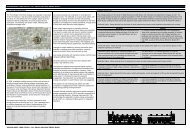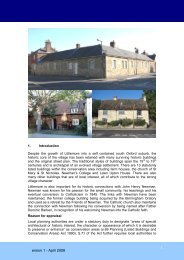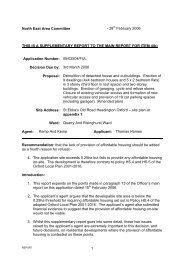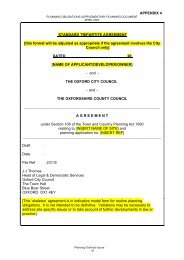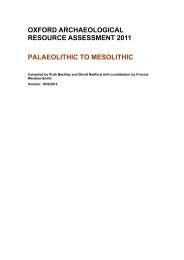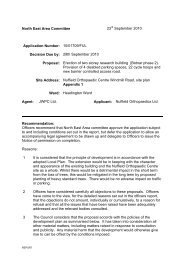Post-medieval Oxford - Oxford City Council
Post-medieval Oxford - Oxford City Council
Post-medieval Oxford - Oxford City Council
Create successful ePaper yourself
Turn your PDF publications into a flip-book with our unique Google optimized e-Paper software.
Social and administrative organisation<br />
Status<br />
In 1542, <strong>Oxford</strong> was designated a city following the creation of the <strong>Oxford</strong> diocese<br />
and the foundation of the cathedral at Oseney, reconfirmed in 1546 when the<br />
cathedral moved to Christ Church (Page ed. 1907: 121). By 1667, the population of<br />
the city had reached c.9000 making it the 11 th largest city in the country. However, by<br />
1851, the population had only grown to c.11,000 and <strong>Oxford</strong> was no longer in the top<br />
20 largest cities (Chalklin 2001: 77).<br />
The Town Hall<br />
In 1229, a building on the east side of St Aldates was acquired as a court room, and<br />
a new gildhall was built in the 1280s. This was extended in 1550 and altered in the<br />
16th and 17th centuries. In 1750, this was demolished (after being recorded by<br />
James Green) and a new Town Hall designed by Isaac Ware was constructed<br />
(Hibbert 1988). This Town Hall was replaced in the 1890s (VCH iv).<br />
The Penniless Bench<br />
The Penniless Bench was built as a lead-roofed lean-to on the east wall of St<br />
Martin's church, Carfax in 1545 by the churchwardens. It was a meeting place for the<br />
city council, but was probably used by beggars, giving rise to the name. On market<br />
days it also served as a butterbench. The bench was rebuilt in stone in 1660 and<br />
removed by 1750 (see Agas' map of <strong>Oxford</strong>, 1587 and Loggan’s map of 1673).<br />
The Butterbench<br />
The Butterbench was erected at the south-west corner of Carfax between 1709 and<br />
1713. It was a colonnade in an entrant angle against the building, planned as the first<br />
of four new corners to Carfax. Carfax was becoming very congested and part of the<br />
bench was removed in 1773 when the covered market opened. The rest was<br />
removed c.1822 (VCH iv: 189).<br />
Social welfare – hospitals<br />
The Radcliffe Infirmary<br />
The Radcliffe Infirmary built with the legacy of John Radcliffe, funded by voluntary<br />
subscription and designed by Stiff Leadbetter, was proposed in 1758 and opened in<br />
1770 (Sherwood and Pevsner 1974: 305). The Infirmary had a series of ancillary<br />
buildings to the rear. Extensive formal grounds and a burial ground fronting onto<br />
Walton Street remained in use until the middle of the 19 th century. An extensive open<br />
area excavation to the west of the Infirmary 2009 recorded extensive garden bedding<br />
trenches, boundary wall and soakaways. The remnants of the 18 th century<br />
brewhouse were represented by some stonewall fragments and a stone barrel<br />
vaulted cellar. The cellar back-fill contained a large quantity of pottery dated to 1807-<br />
1820 which corresponds to the documented date for the brewhouse demolition and<br />
its replacement with a conservatory. To the south and west of the brewhouse, a<br />
further stone cellar was later reused as a soakaway for at least two brick-lined rain<br />
water drains. The collection and management of water within the hospital was also<br />
evidenced in a stone-lined drainage cistern, fed by five stone lined drains from the<br />
rear of the infirmary building and one from the building associated with the second<br />
stone-lined vaulted cellar (Braybrooke 2010). Burials from the Infirmary Burial<br />
Ground were recorded during the construction work in the 1930s (Dudley Buxton,<br />
1937) and during subsequent evaluations in 2007 (Watson 2007) and 2009<br />
(Braybrooke 2009b). In 2009, a total of 36 identifiable burials were recorded and a<br />
OXFORD ARCHAEOLOGICAL RESOURCE ASSESSMENT- POST MEDIEVAL<br />
24



